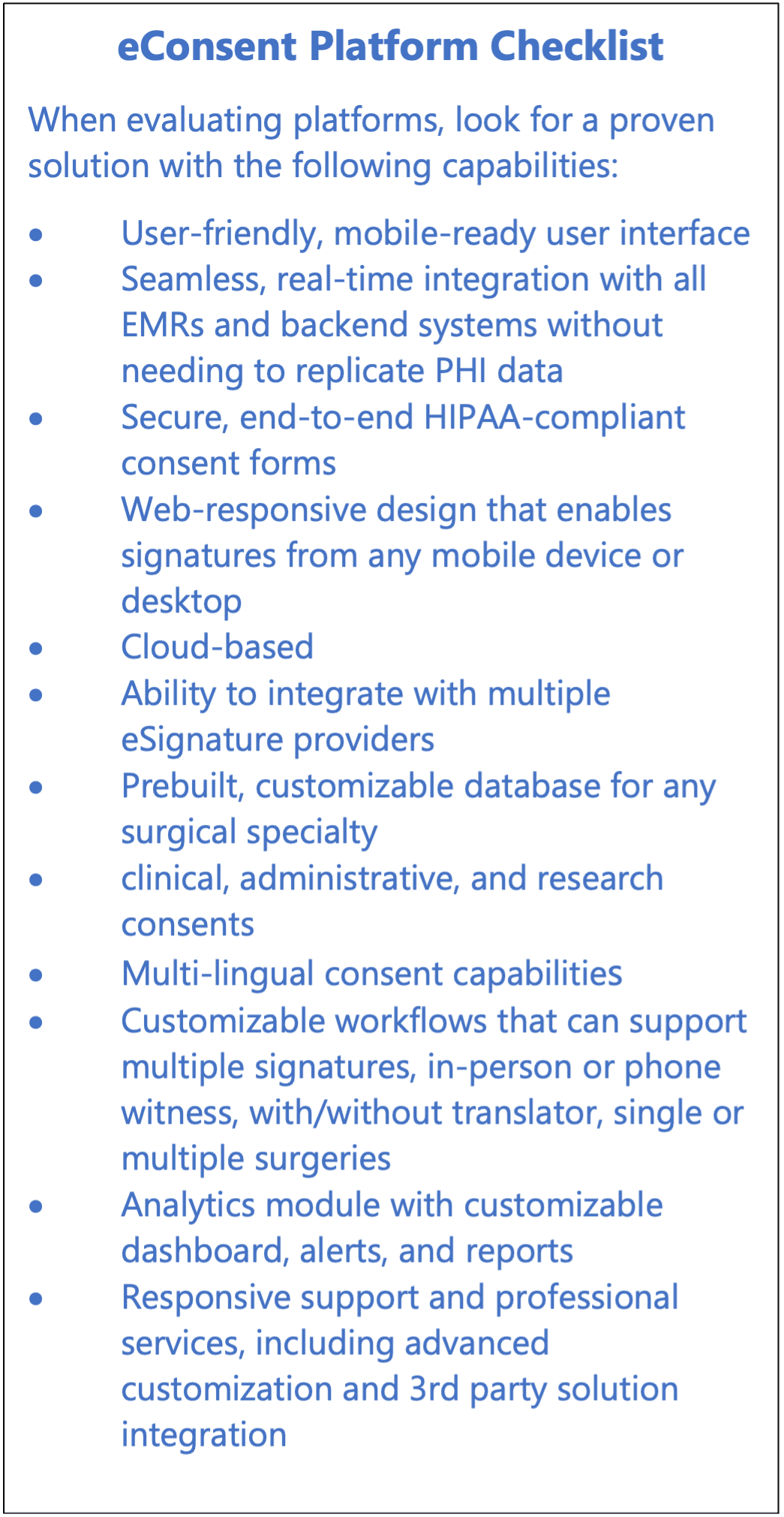And What to Look for in an eConsent Platform
While much of healthcare has been digitized, surgical and other patient consent forms still too often rely on paper forms. That’s unfortunate, because the costs and disadvantages of obtaining consent by paper are enormous, including:
- Wasted time for surgeons, anesthesiologists, and clinical and administrative staff
- Higher supply and staffing costs
- Lower patient and physician satisfaction
- Greater liability exposure
- Potentially delayed or lower-quality care
Paper forms waste both administrative and clinical staff time because data must be collected and re-entered manually. That not only causes duplication of effort and massive paper and handling costs, but often results in lost or misfiled documents, errors, and even delayed surgical procedures or care.
One study of paper consent forms determined that they resulted in missing signed consent forms at surgery for two-thirds of patients, which in turn delayed surgery in 14% of total cases. Another study found that electronic, procedure-specific forms improved numerous issues with hand-written surgical consent forms, including missing patient information in 10%, missing procedure details in 30% and patient sign-off issues in 27%. Yet a surprising number of providers still rely on paper consent forms.
Today, high-performing eConsent platforms are available that can be integrated with EMRs and that make it easy for providers to generate, distribute, have signed, and save consent forms for any patient in any place, on any device. And all of that can save thousands or even millions of dollars every year, creating a powerful incentive for medical practices and healthcare systems to make the switch from outmoded paper processes to more efficient and effective digital ones.
5 Reasons to Switch to eConsent Now
Using an electronic consent platform can reduce staff, and supply costs; improve physician, staff, and patient satisfaction; lower liability risks, and improve the delivery and quality of care. Each of these advantages is described in more detail below.
1. Lower costs
eConsent can eliminate printing costs of approximately one dollar per consent form as well as dramatically reduce handling costs, which can cost four to seven dollars per form. By contrast, each eConsent form costs only about a dollar and per-form costs decrease as the platform becomes more efficiently utilized. The potential savings for a 300-bed hospital with 14 operating rooms, which typically needs to generate and process about a million consent forms a year (assuming 100,000 consent forms for procedures per year plus 900,000 other consent forms), could be $2 to $6 million dollars per year.

In addition to lowering costs, eConsent enables organizations to modify forms dynamically without having to reprint them or worry that the most current version is not being used throughout the organization. That’s priceless.
2. Save physician and staff time while improving satisfaction
An electronic consent platform can save surgeons and anesthesiologists considerable time because they no longer must re-enter consent information for each patient. Instead, key information, such as surgical benefits, risks, alternatives, laterality, and attachments, can be automatically populated to the consent form while making it easy for patients to read and understand. The convenience alone will help to improve physician, staff, and patient satisfaction.
3. Improve patient convenience and satisfaction
Not surprisingly, over half of the healthcare leaders responding to a 2021 survey stated that their patients prefer electronic forms to paper. With digital consent, patients no longer have to be physically present at the provider’s location to sign forms. Instead, they can sign them at any time or place, whether in a healthcare setting, at home, or on the go. This ability to complete consent forms remotely is not only useful during a pandemic, but also for telehealth visits and other forms of remote care.
Consent platforms that use web responsive design provide additional convenience because patients can sign their consent form(s) on the device of their choice, whether that’s a mobile phone, tablet, desktop computer, or laptop.
4. Reduce liability

For decades, digital signatures have been as legally binding as a hand-written signature. When using eConsent, surgeons and other
healthcare providers can more consistently capture and document precisely what they explained to their patients. Unlike a paper form that can be damaged, lost, or misfiled, eConsent enabled patients to be more informed and protected while providing proof that discussions have taken place.
Today’s leading eConsent platforms offer auditing capabilities that enable the healthcare organization to manage and report changes in consent forms for auditing, compliance, quality, and safety purposes.
Electronic consent also makes it easy for surgeons and other providers to customize the consent for higher-risk patients, such as those with a co-morbid condition.
5. Increase accuracy, speed, and quality
Eliminating potential errors caused by entering information manually and preventing lost or misfiled forms can significantly improve the quality of care. For example, a patient in the ED can sign the eConsent there and have the form immediately and securely sent to the surgeon in the OR, preventing delayed procedures due to lost forms.
What to Look for in a Digital Consent Platform
A well-designed consent platform should:
- Seamlessly integrate with EMRs and other IT systems
- Be easy for patients, physicians, and staff to learn and use
- Offer secure, HIPAA-compliant consent on any mobile device in any location
- Include analytics capabilities
Refer to our eConsent Platform Checklist for a more complete list of essential capabilities to seek when selecting a platform.
Harris Novum recently acquired Agile Consent, a leading electronic consent platform. Since 2016, Agile Consent has been used to securely and efficiently consent thousands of patients. For more information, contact us at AgileConsent@harriscomputer.com.
